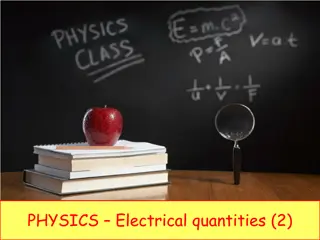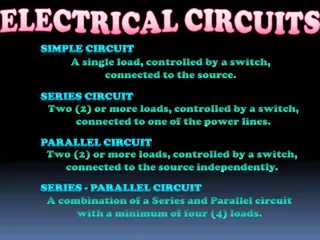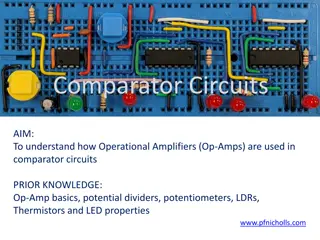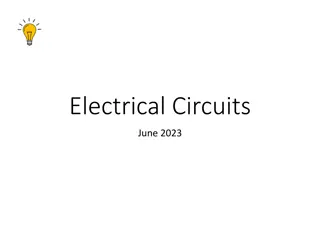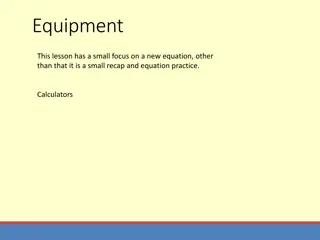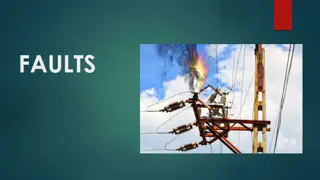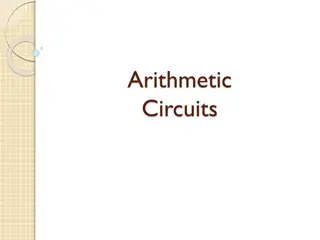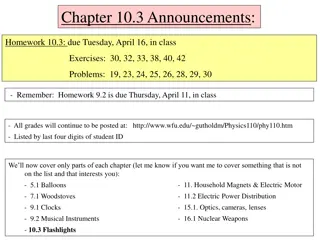Understanding Electrical Circuits: Basics and Types
The presentation covers the basics of electrical circuits, explaining the concept of electric current, the role of cells and batteries, simple circuit components like switches and lamps, and circuit diagrams. It further delves into types of circuits - series circuits and parallel circuits, detailing how they are connected and how they operate. The visuals help in understanding the flow of electric current and the implications of different circuit configurations.
Download Presentation

Please find below an Image/Link to download the presentation.
The content on the website is provided AS IS for your information and personal use only. It may not be sold, licensed, or shared on other websites without obtaining consent from the author. Download presentation by click this link. If you encounter any issues during the download, it is possible that the publisher has removed the file from their server.
E N D
Presentation Transcript
ELECTRICAL CIRCUITS S.MORRIS 2006 More free powerpoints at www.worldofteaching.com
The CELL The cell stores chemical energy and transfers it to electrical energy when a circuit is connected. When two or more cells are connected together we call this a Battery. The cells chemical energy is used up pushing a current round a circuit.
What is an electric current? An electric current is a flow of microscopic particles called electrons flowing through wires and components. - + In which direction does the current flow? from the Negative terminal to the Positive terminal of a cell.
simple circuits Here is a simple electric circuit. It has a cell, a lamp and a switch. wires cell lamp switch To make the circuit, these components are connected together with metal connecting wires.
simple circuits When the switch is closed, the lamp lights up. This is because there is a continuous path of metal for the electric current to flow around. If there were any breaks in the circuit, the current could not flow.
circuit diagram Scientists usually draw electric circuits using symbols; cell lamp switch wires
circuit diagrams In circuit diagrams components are represented by the following symbols; cell battery switch lamp buzzer ammeter voltmeter motor resistor variable resistor
types of circuit There are two types of electrical circuits; SERIES CIRCUITS PARALLEL CIRCUITS
SERIES CIRCUITS The components are connected end-to-end, one after the other. They make a simple loop for the current to flow round. If one bulb blows it breaks the whole circuit and all the bulbs go out.
PARALLEL CIRCUITS The components are connected side by side. The current has a choice of routes. If one bulb blows there is still be a complete circuit to the other bulb so it stays alight.
measuring current Electric current is measured in amps (A) using an ammeter connected in series in the circuit. A
measuring current This is how we draw an ammeter in a circuit. A A PARALLEL CIRCUIT SERIES CIRCUIT
measuring current SERIES CIRCUIT current is the same at all points in the circuit. 2A 2A 2A PARALLEL CIRCUIT 2A 2A current is shared between the components 1A 1A
copy the following circuits and fill in the missing ammeter readings. 3A ? 3A 4A ? 1A ? 4A ? 1A 4A 1A ?
measuring voltage The electrical push which the cell gives to the current is called the voltage. It is measured in volts (V) on a voltmeter V
measuring voltage Different cells produce different voltages. The bigger the voltage supplied by the cell, the bigger the current. Unlike an ammeter a voltmeter is connected across the components Scientist usually use the term Potential Difference (pd) when they talk about voltage.
measuring voltage This is how we draw a voltmeter in a circuit. V V SERIES CIRCUIT PARALLEL CIRCUIT
measuring voltage V V V V
series circuit voltage is shared between the components 3V 1.5V 1.5V
parallel circuit voltage is the same in all parts of the circuit. 3V 3V 3V
measuring current & voltage copy the following circuits on the next two slides. complete the missing current and voltage readings. remember the rules for current and voltage in series and parallel circuits.
measuring current & voltage a) 6V 4A A V V A
measuring current & voltage b) 6V 4A A V A V A
answers a) b) 6V 4A 6V 4A 6V 4A 4A 2A 3V 3V 4A 6V 2A






